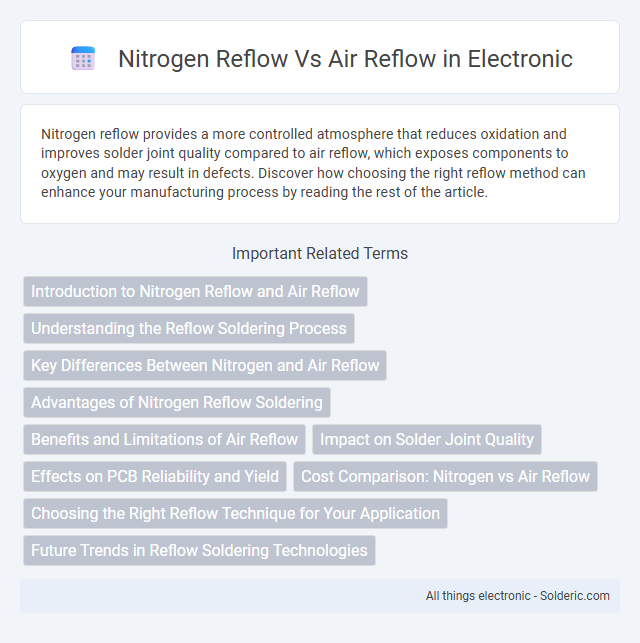Nitrogen reflow provides a more controlled atmosphere that reduces oxidation and improves solder joint quality compared to air reflow, which exposes components to oxygen and may result in defects. Discover how choosing the right reflow method can enhance your manufacturing process by reading the rest of the article.
Comparison Table
| Feature | Nitrogen Reflow | Air Reflow |
|---|---|---|
| Atmosphere | Inert nitrogen gas | Ambient air |
| Oxidation | Minimal oxidation, improves solder joint quality | Higher oxidation, possible solder defects |
| Soldering Temperature | Stable and uniform heat distribution | Potential hot spots, less uniform heating |
| Defect Rate | Lower defect rates, fewer solder bridges | Higher defect rates, more solder flaws |
| Cost | Higher initial and operational costs (nitrogen supply) | Lower cost, no special gas needed |
| Environmental Impact | Reduced oxidation leads to less scrap | More oxidation-generated waste |
| Application | High-reliability electronics, fine-pitch components | General electronics manufacturing |
Introduction to Nitrogen Reflow and Air Reflow
Nitrogen reflow utilizes an oxygen-reduced nitrogen environment to enhance solder joint quality by minimizing oxidation and improving wetting, resulting in stronger and more reliable connections. Air reflow relies on ambient air, which contains oxygen that can cause oxidation on solder surfaces, potentially leading to defects such as solder balling or bridging. Comparing both methods reveals that nitrogen reflow typically yields superior soldering outcomes in high-reliability applications, while air reflow is more cost-effective for standard electronics manufacturing.
Understanding the Reflow Soldering Process
The reflow soldering process involves heating solder paste to bond electronic components to printed circuit boards (PCBs) with precision and reliability. Nitrogen reflow utilizes an inert nitrogen atmosphere to minimize oxidation and enhance solder joint quality, leading to improved electrical performance and reduced defects. Air reflow, while more economical, exposes components to oxygen, potentially causing oxidation and less consistent solder joints, making nitrogen reflow the preferred choice for high-reliability applications.
Key Differences Between Nitrogen and Air Reflow
Nitrogen reflow soldering uses an inert nitrogen atmosphere to minimize oxidation, resulting in cleaner solder joints and improved reliability compared to air reflow, which operates in ambient air with higher oxygen levels. The absence of oxygen in nitrogen reflow reduces the formation of solder defects like voids and bridges, enhancing overall solderability and product quality. Your choice between nitrogen and air reflow impacts production cost and defect rates, with nitrogen typically offering higher performance but at increased operational expenses.
Advantages of Nitrogen Reflow Soldering
Nitrogen reflow soldering offers significant advantages, including reduced oxidation during the soldering process, which enhances solder joint reliability and quality. The presence of nitrogen creates an inert atmosphere that minimizes the formation of solder defects such as voids and improves wetting properties, leading to stronger and more consistent connections. Your electronics manufacturing process benefits from cleaner solder joints, fewer rework cycles, and improved overall product performance compared to air reflow soldering.
Benefits and Limitations of Air Reflow
Air reflow soldering offers cost-effective and straightforward implementation, making it suitable for low to medium-volume production runs. It tends to have higher oxidation rates compared to nitrogen reflow, which can lead to increased solder defects and reduced joint reliability. Despite its limitations in minimizing oxidation and enhancing solder quality, air reflow remains a viable option when budget constraints outweigh the need for superior solder joint performance.
Impact on Solder Joint Quality
Nitrogen reflow significantly enhances solder joint quality by providing an oxygen-free environment that reduces oxidation and improves wetting, resulting in stronger, more reliable connections. In contrast, air reflow exposes solder joints to oxygen, leading to increased oxidation and potentially weaker joints with more defects such as voids and tombstoning. Choosing nitrogen reflow can improve your PCB assembly's overall reliability and performance by ensuring cleaner, higher-quality solder joints.
Effects on PCB Reliability and Yield
Nitrogen reflow significantly improves PCB reliability and yield by minimizing oxidation during soldering, resulting in stronger solder joints and reduced defects. Air reflow exposes PCBs to oxygen, increasing the risk of solder oxidation, which can lead to weaker joints and higher rates of defects or rework. Using nitrogen reflow environments enhances solderability and long-term performance, making it the preferred choice for high-quality manufacturing processes.
Cost Comparison: Nitrogen vs Air Reflow
Nitrogen reflow typically incurs higher operational costs due to the need for specialized gas supply and equipment maintenance, while air reflow offers a more cost-effective solution by using ambient air without extra gas expenses. Although the initial investment for nitrogen reflow systems can be substantial, the improved solder joint quality and reduced defects may lead to lower rework and warranty costs over time. Your choice between nitrogen and air reflow should consider both immediate budget constraints and long-term production efficiency.
Choosing the Right Reflow Technique for Your Application
Choosing the right reflow technique depends on your specific application requirements, such as component sensitivity and oxidation concerns. Nitrogen reflow offers a controlled, oxygen-free environment that minimizes oxidation, enhancing solder joint reliability for high-precision electronics. Air reflow is more cost-effective for applications with less stringent oxidation control but may increase the risk of defects in sensitive components.
Future Trends in Reflow Soldering Technologies
Nitrogen reflow soldering offers enhanced oxidation prevention and improved joint reliability compared to traditional air reflow methods, driving its adoption in advanced electronics manufacturing. Future trends indicate rising integration of smart sensors and AI-driven control systems to optimize nitrogen usage and reflow profiles for superior thermal management. Sustainability efforts prioritize reducing nitrogen consumption while maintaining high-quality solder joints, merging eco-friendly practices with cutting-edge reflow technology advancements.
Nitrogen reflow vs air reflow Infographic

 solderic.com
solderic.com